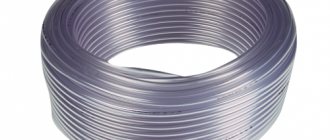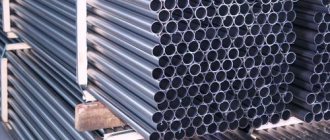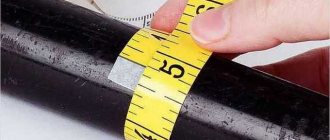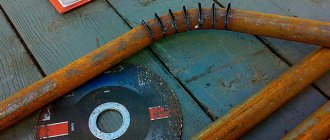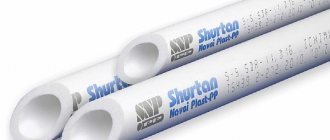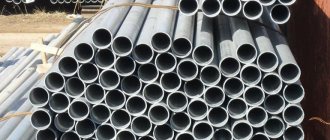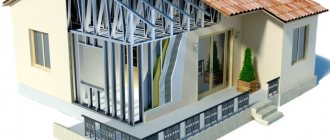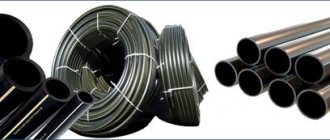The pipe calculator is used to calculate the weight of a linear meter or a given length of a pipe made of various metals (steel, duralumin, lead, titanium and other alloys).
This review contains three online pipe calculators (for round, rectangular and square pipes) and a program for calculating the mass of pipes offline.
Download pipe calculator
In addition to the ability to calculate the mass of a pipe online, you can download the “pipe calculator” program. This program is small and does not require installation.
The program for calculating the mass of pipes is completely identical to the online calculators presented above and uses the following calculation method:
To calculate the mass of round pipes, use the formula m = Pi * ro * S * (D - S) * L, where:
- Pi = 3.1415926.
- ro is the density of the pipe material.
- S - wall.
- D is the outer diameter.
- L is the length of the pipe.
The mass of rectangular pipes is calculated using an interpolation formula. The masses of pipes in accordance with GOST 8645-68 “Rectangular steel pipes” and GOST 8639-82 “Square steel pipes” are taken as nodal points. For intermediate sizes, the calculation is made according to the formula m = Kp * 0.0157 * S * (A + B - 2.86 * S) * L, where:
- Kp is the density coefficient.
- m—mass, kg.
- S—wall, mm.
- A - large side, mm.
- B—smaller side, mm.
- L—length, m.
The pipe calculator uses the following densities (kg/m³):
| Material, brand | Density |
| Carbon steel | 7850 |
| 04Х18Н10 | 7900 |
| 06XH28MDT | 7960 |
| 08X13 | 7700 |
| 08X17T | 7700 |
| 08X20H14C2 | 7700 |
| 08X18H10 | 7900 |
| 08X18H10T | 7900 |
| 08X18H12T | 7950 |
| 08X17H15M3T | 8100 |
| 08X22H6T | 7600 |
| 08X18H12B | 7900 |
| 10X17H13M2T | 8000 |
| 10X23H18 | 7950 |
| 12X13 | 7700 |
| 12X17 | 7700 |
| 12X18H10T | 7950 |
| 12X18H12T | 7900 |
| 12X18H9 | 7900 |
| 15X25T | 7600 |
| 17X18H9 | 7900 |
| Duralumin | 2850 |
| Titanium | 4540 |
| Copper | 8960 |
| Brass | 8600 |
| Lead | 11340 |
| Gold | 19300 |
Square steel pipe weight
The main dimensions of a square steel pipe
Calculation of the theoretical weight of a square pipe is regulated by GOST 8639-82.
The weight and standard dimensions of steel square pipes are given in Table 1: Table 1. Main dimensions and weight of steel square pipes according to GOST 8639-82
| Pipe side A, mm | Wall thickness S, mm | Weight 1 m, kg |
| 10 | 0,8 | 0,222 |
| 0,9 | 0,246 | |
| 1,0 | 0,269 | |
| 1,2 | 0,312 | |
| 1,4 | 0,352 | |
| 15 | 0,8 | 0,348 |
| 0,9 | 0,388 | |
| 1,0 | 0,426 | |
| 1,2 | 0,501 | |
| 1,4 | 0,571 | |
| 1,5 | 0,605 | |
| 20 | 0,8 | 0,474 |
| 0,9 | 0,529 | |
| 1,0 | 0,593 | |
| 1,2 | 0,689 | |
| 1,4 | 0,791 | |
| 1,5 | 0,841 | |
| 1,5 | 1,075 | |
| 25 | 0,8 | 0,599 |
| 0,9 | 0,670 | |
| 1,0 | 0,740 | |
| 1,2 | 0,878 | |
| 1,4 | 1,01 | |
| 1,5 | 1,07 | |
| 2,0 | 1,39 | |
| 2,5 | 1,68 | |
| 3,0 | 1,95 | |
| 30 | 0,8 | 0,725 |
| 0,9 | 0,811 | |
| 1,0 | 0,897 | |
| 1,2 | 1,07 | |
| 1,3 | 1,15 | |
| 1,4 | 1,237 | |
| 1,5 | 1,31 | |
| 2,0 | 1,70 | |
| 2,5 | 2,07 | |
| 3,0 | 2,42 | |
| 3,5 | 2,75 | |
| 4,0 | 3,04 | |
| 32 | 4,0 | 3,30 |
| 35 | 0,8 | 0,85 |
| 0,9 | 0,953 | |
| 1,4 | 1,45 | |
| 1,5 | 1,55 | |
| 2,0 | 2,02 | |
| 2,5 | 2,46 | |
| 3,0 | 2,89 | |
| 3,5 | 3,30 | |
| 4,0 | 3,67 | |
| 5,0 | 4,37 | |
| 36 | 4,0 | 3,80 |
| 40 | 1,4 | 1,67 |
| 1,5 | 1,78 | |
| 2,0 | 2,33 | |
| 2,5 | 2,85 | |
| 3,0 | 3,36 | |
| 3,5 | 3,85 | |
| 4,0 | 4,30 | |
| 5,0 | 5,16 | |
| 6,0 | 5,92 | |
| 42 | 3,0 | 3,55 |
| 3,5 | 4,07 | |
| 4,0 | 4,56 | |
| 5,0 | 5,47 | |
| 6,0 | 6,30 | |
| 45 | 2,0 | 2,65 |
| 3,0 | 3,83 | |
| 3,5 | 4,40 | |
| 4,0 | 4,93 | |
| 5,0 | 5,94 | |
| 6,0 | 6,86 | |
| 7,0 | 7,69 | |
| 8,0 | 8,43 | |
| 50 | 2,0 | 2,96 |
| 2,5 | 3,64 | |
| 3,0 | 4,31 | |
| 3,5 | 4,94 | |
| 4,0 | 5,56 | |
| 4,5 | 6,16 | |
| 5,0 | 6,73 | |
| 6,0 | 7,80 | |
| 7,0 | 8,79 | |
| 8,0 | 9,69 | |
| 55 | 3,0 | 4,78 |
| 60 | 2,0 | 3,59 |
| 2,5 | 4,43 | |
| 3,0 | 5,25 | |
| 3,5 | 6,04 | |
| 4,0 | 6,82 | |
| 5,0 | 8,30 | |
| 6,0 | 9,69 | |
| 7,0 | 11,0 | |
| 8,0 | 12,20 | |
| 65 | 6,0 | 10,63 |
| 70 | 3,0 | 6,19 |
| 3,5 | 7,14 | |
| 4,0 | 8,07 | |
| 5,0 | 9,87 | |
| 6,0 | 11,57 | |
| 7,0 | 13,19 | |
| 8,0 | 14,71 | |
| 80 | 3,0 | 7,13 |
| 3,5 | 8,24 | |
| 4,0 | 9,33 | |
| 5,0 | 11,44 | |
| 6,0 | 13,46 | |
| 7,0 | 15,38 | |
| 8,0 | 17,22 | |
| 9,0 | 18,97 | |
| 10,0 | 20,63 | |
| 11,0 | 22,20 | |
| 90 | 3,0 | 8,07 |
| 4,0 | 10,59 | |
| 5,0 | 13,00 | |
| 6,0 | 15,34 | |
| 7,0 | 17,58 | |
| 8,0 | 19,73 | |
| 100 | 3,0 | 9,02 |
| 4,0 | 11,84 | |
| 5,0 | 14,58 | |
| 6,0 | 17,22 | |
| 7,0 | 19,78 | |
| 8,0 | 22,25 | |
| 9,0 | 24,62 | |
| 110 | 6,0 | 19,11 |
| 7,0 | 21,98 | |
| 8,0 | 24,76 | |
| 9,0 | 27,45 | |
| 120 | 6,0 | 20,99 |
| 7,0 | 24,18 | |
| 8,0 | 27,27 | |
| 9,0 | 30,28 | |
| 140 | 6,0 | 24,76 |
| 7,0 | 28,57 | |
| 8,0 | 32,29 | |
| 9,0 | 35,93 | |
| 150 | 7,0 | 30,77 |
| 8,0 | 34,81 | |
| 9,0 | 38,75 | |
| 10,0 | 42,61 | |
| 180 | 8,0 | 42,34 |
| 9,0 | 47,23 | |
| 10,0 | 52,03 | |
| 12,0 | 61,36 | |
| 14,0 | 70,33 |
Note
- Weight calculated at steel density 7.85 g/cm3
- Pipes of the following sizes are produced to order: 32, 36, 40, 55, 65 mm
- It is possible to manufacture pipes of different standard sizes upon agreement between the manufacturer and the buyer.
GOST and TU regulating pipe weight calculator
GOST and TU standards for round pipes:
- GOST 494-2014 (x/d) - Brass pipes. Cold-worked.
- GOST 9941-81 — Cold- and heat-deformed seamless pipes made of corrosion-resistant steel.
- GOST 10707-80 — Cold-deformed electric-welded steel pipes.
- GOST 494-2014 (p) - Brass pipes. Pressed.
- GOST 617-2006 (p) - Copper and brass pipes of round section for general purpose. Pressed.
- GOST 3262-75 — Steel water and gas pipes. Galvanized.
- GOST R 52318-2005 — Round copper pipes for water and gas.
- GOST 32598-2013 — Round copper pipes for water and gas.
- GOST 617-2006 (x/d) - Copper and brass pipes of round section for general purpose. Cold-worked.
- GOST 10704-91 — Electric-welded straight-seam steel pipes.
- GOST 18482-2018 — Pressed pipes made of aluminum and aluminum alloys.
GOST and TU standards for square and rectangular pipes:
- GOST 16774-2015 - Copper pipes of rectangular and square sections (Square).
- GOST 8639-82 — Square steel pipes.
Weight of profile steel pipe
The main dimensions of a profile rectangular pipe
The calculation of the theoretical weight of a steel profile pipe is regulated by GOST 8645-68.
The weight and standard dimensions of rectangular pipes are given in Table 2: Table 2. Main standard sizes and weights of steel rectangular pipes according to GOST 8645-68
| Profile width A, mm | Profile height B, mm | S, mm | Weight 1 m, kg |
| 15 | 10 | 1,0 | 0,348 |
| 1,5 | 0,488 | ||
| 2 | 0,605 | ||
| 20 | 10 | 1,0 | 0,426 |
| 1,5 | 0,605 | ||
| 2 | 0,762 | ||
| 15 | 1,0 | 0,505 | |
| 1,5 | 0,723 | ||
| 2 | 0,919 | ||
| 2,5 | 1,09 | ||
| 25 | 10 | 1,0 | 0,505 |
| 1,5 | 0,723 | ||
| 2 | 0,919 | ||
| 2,5 | 1,09 | ||
| 15 | 1,0 | 0,583 | |
| 1,5 | 0,841 | ||
| 2 | 1,08 | ||
| 2,5 | 1,29 | ||
| 28 | 25 | 1,5 | 1,15 |
| 2 | 1,49 | ||
| 2,5 | 1,80 | ||
| 30 | 10 | 1,0 | 0,583 |
| 1,5 | 0,841 | ||
| 2 | 1,08 | ||
| 2,5 | 1,29 | ||
| 3 | 1,48 | ||
| 15 | 1,0 | 0,661 | |
| 1,5 | 0,959 | ||
| 2 | 1,23 | ||
| 2,5 | 1,48 | ||
| 3 | 1,71 | ||
| 20 | 1,0 | 0,740 | |
| 1,5 | 1,08 | ||
| 2 | 1,39 | ||
| 2,5 | 1,68 | ||
| 3 | 1,95 | ||
| 35 | 15 | 1,5 | 1,08 |
| 2 | 1,39 | ||
| 2,5 | 1,68 | ||
| 3 | 1,95 | ||
| 3,5 | 2,20 | ||
| 20 | 1,5 | 1,19 | |
| 2 | 1,55 | ||
| 2,5 | 1,88 | ||
| 3 | 2,19 | ||
| 3,5 | 2,47 | ||
| 25 | 1,5 | 1,31 | |
| 2 | 1,70 | ||
| 2,5 | 2,07 | ||
| 3 | 2,42 | ||
| 3,5 | 2,75 | ||
| 40 | 15 | 2 | 1,55 |
| 2,5 | 1,88 | ||
| 3 | 2,19 | ||
| 3,5 | 2,47 | ||
| 4 | 2,73 | ||
| 20 | 2 | 1,70 | |
| 2,5 | 2,07 | ||
| 3 | 2,42 | ||
| 3,5 | 2,75 | ||
| 4 | 3,05 | ||
| 25 | 1,5 | 1,43 | |
| 2 | 1,86 | ||
| 2,5 | 2,27 | ||
| 3 | 2,66 | ||
| 3,5 | 3,02 | ||
| 4 | 3,36 | ||
| 28 | 1,5 | 1,50 | |
| 2 | 1,95 | ||
| 2,5 | 2,39 | ||
| 30 | 2 | 2,02 | |
| 2,5 | 2,47 | ||
| 3 | 2,89 | ||
| 3,5 | 3,30 | ||
| 4 | 3,68 | ||
| (42) | 20 | 2 | 1,77 |
| 2,5 | 2,15 | ||
| 3 | 2,52 | ||
| 3,5 | 2,86 | ||
| 4 | 3,17 | ||
| 30 | 2 | 2,08 | |
| 2,5 | 2,54 | ||
| 3 | 2,99 | ||
| 3,5 | 3,41 | ||
| 4 | 3,80 | ||
| 45 | 20 | 2 | 1,86 |
| 2,5 | 2,27 | ||
| 3 | 2,66 | ||
| 3,5 | 3,02 | ||
| 4 | 3,36 | ||
| 30 | 2 | 2,17 | |
| 2,5 | 2,66 | ||
| 3 | 3,13 | ||
| 3,5 | 3,57 | ||
| 4 | 3,99 | ||
| 50 | 25 | 2 | 2,17 |
| 2,5 | 2,66 | ||
| 3 | 3,13 | ||
| 3,5 | 3,57 | ||
| 4 | 3,99 | ||
| 30 | 2 | 2,32 | |
| 2,5 | 2,86 | ||
| 3 | 3,36 | ||
| 3,5 | 3,857 | ||
| 4 | 4,30 | ||
| 35 | 2 | 2,49 | |
| 2,5 | 3,09 | ||
| 3 | 3,60 | ||
| 3,5 | 4,12 | ||
| 4 | 4,62 | ||
| 40 | 2 | 2,65 | |
| 2,5 | 3,25 | ||
| 3 | 3,83 | ||
| 3,5 | 4,39 | ||
| 4 | 4,93 | ||
| 60 | 25 | 2,5 | 3,05 |
| 3 | 3,60 | ||
| 3,5 | 4,12 | ||
| 4 | 4,62 | ||
| 5 | 5,55 | ||
| 30 | 2,5 | 3,25 | |
| 3 | 3,83 | ||
| 3,5 | 4,39 | ||
| 4 | 4,93 | ||
| 5 | 5,94 | ||
| 40 | 3 | 4,30 | |
| 3,5 | 4,94 | ||
| 4 | 5,56 | ||
| 5 | 6,73 | ||
| 70 | 30 | 3 | 4,30 |
| 3,5 | 4,94 | ||
| 4 | 5,56 | ||
| 5 | 6,73 | ||
| 6 | 7,80 | ||
| 40 | 3 | 4,78 | |
| 3,5 | 5,49 | ||
| 4 | 6,19 | ||
| 5 | 7,51 | ||
| 6 | 8,75 | ||
| 50 | 3 | 5,25 | |
| 3,5 | 6,04 | ||
| 4 | 6,82 | ||
| 5 | 8,30 | ||
| 6 | 9,69 | ||
| 7 | 10,99 | ||
| 80 | 40 | 3 | 5,25 |
| 3,5 | 6,04 | ||
| 4 | 6,82 | ||
| 5 | 8,30 | ||
| 6 | 9,69 | ||
| 7 | 10,99 | ||
| 50 | 3 | 5,72 | |
| 3,5 | 6,59 | ||
| 4 | 7,44 | ||
| 60 | 3,5 | 7,14 | |
| 4 | 8,07 | ||
| 5 | 9,87 | ||
| 6 | 11,57 | ||
| 7 | 13,19 | ||
| 90 | 40 | 3,5 | 6,59 |
| 4 | 7,44 | ||
| 5 | 9,08 | ||
| 6 | 10,63 | ||
| 7 | 12,09 | ||
| 50 | 3 | 6,19 | |
| 60 | 4 | 8,70 | |
| 5 | 10,65 | ||
| 6 | 12,51 | ||
| 7 | 14,29 | ||
| 100 | 40 | 4 | 8,07 |
| 5 | 9,87 | ||
| 6 | 11,57 | ||
| 7 | 13,19 | ||
| 50 | 4 | 6,19 | |
| 5 | 10,65 | ||
| 6 | 12,51 | ||
| 7 | 14,29 | ||
| 70 | 4 | 9,96 | |
| 5 | 12,22 | ||
| 6 | 14,40 | ||
| 7 | 16,48 | ||
| 110 | 40 | 4 | 8,70 |
| 5 | 10,65 | ||
| 6 | 12,51 | ||
| 7 | 14,29 | ||
| 50 | 4 | 9,33 | |
| 5 | 11,44 | ||
| 6 | 13,46 | ||
| 7 | 15,38 | ||
| 60 | 4 | 9,96 | |
| 5 | 12,22 | ||
| 6 | 14,40 | ||
| 7 | 16,48 | ||
| 120 | 40 | 5 | 11,44 |
| 6 | 13,46 | ||
| 7 | 15,38 | ||
| 8 | 17,22 | ||
| 60 | 5 | 13,00 | |
| 6 | 15,34 | ||
| 7 | 17,58 | ||
| 8 | 19,73 | ||
| 80 | 5 | 14,58 | |
| 6 | 17,22 | ||
| 7 | 19,78 | ||
| 8 | 22,25 | ||
| 140 | 60 | 3 | 9,02 |
| 5 | 14,58 | ||
| 6 | 17,22 | ||
| 7 | 19,78 | ||
| 8 | 22,25 | ||
| 80 | 5 | 16,15 | |
| 6 | 19,11 | ||
| 7 | 21,98 | ||
| 8 | 24,76 | ||
| 120 | 6 | 22,88 | |
| 7 | 26,37 | ||
| 8 | 29,78 | ||
| 9 | 33,10 | ||
| 150 | 60 | 7 | 20,88 |
| 80 | 6 | 20,05 | |
| 7 | 23,08 | ||
| 8 | 26,01 | ||
| 9 | 28,86 | ||
| 10 | 31,62 | ||
| 100 | 6 | 21,93 | |
| 7 | 25,28 | ||
| 8 | 28,53 | ||
| 9 | 31,69 | ||
| 10 | 34,76 | ||
| 160 | 130 | 8 | 33,55 |
| 180 | 80 | 7 | 26,37 |
| 8 | 29,78 | ||
| 9 | 33,10 | ||
| 10 | 36,33 | ||
| 12 | 42,52 | ||
| 100 | 8 | 32,29 | |
| 9 | 35,93 | ||
| 10 | 39,47 | ||
| 12 | 46,29 | ||
| 145 | 20 | 84,10 | |
| 150 | 8 | 38,57 | |
| 9 | 42,99 | ||
| 10 | 47,32 | ||
| 12 | 55,71 | ||
| 190 | 120 | 12 | 51,94 |
| 196 | 170 | 18 | 88,99 |
| 200 | 120 | 8 | 37,32 |
| 230 | 100 | 8 | 38,57 |
General information about the profile pipe
In large-scale production, the production of round pipes requires much less costs, both in terms of time and the equipment involved in the process, compared to non-standard profile analogues. But the profile pipe has an extremely significant advantage, thanks to which it is in demand not only in construction, but also in the production of various products - an increased contact area.
The easiest way to imagine this parameter is if you attach two pipes of the same diameter one to the other. For round pipes, the contact edge is point (linear). The profile pipe is in contact with the attached element with its entire plane. This contact facilitates fixation and makes it much stronger. This same advantage makes transportation of profile pipes more efficient, because being tightly laid, there is no gap between them, they do not crumble and, with the same dimensions, have less weight (compared to analogues with a round cross-section).
Another significant advantage in calculating the load on a profile pipe and deflection in an online calculator is that they have higher fracture strength. This aspect is especially taken into account when choosing between profiles of different sections and volumes.
Calculating a linear meter - how to calculate correctly? Review
Inexperienced or novice builders do not know how to calculate linear meters.
These parameters are used when performing repair or construction work, even when purchasing furniture.
The calculation of a linear meter arises when it is necessary to facilitate the calculation of the quantity of products, for example, linoleum, curtains, skirting boards, carpet, pipes, and the like.
This concept is almost no different from the concept of length, only the width of the material is taken into account.
Most often, the width of a certain product or floor covering is considered a standard value and if it is necessary to calculate a linear meter, then they are not taken into account.
Preparation for the procedure
To calculate the linear meter of flooring for rooms, it is worth measuring its width and length.
Measurement Tools
To measure the width and length of a room, use a tool such as a tape measure, and if you don’t have a tape measure, you can use a regular measuring tape.
In order not to forget the results, it is best to write them down in a notebook or on a piece of paper, only then can you go shopping in the store. Having all the measurements, you can make a choice yourself or you can turn to sales consultants for help.
Example
For example, if the width of your corridor is two meters and its length is four meters, then you will need to buy four linear meters of flooring, which is two meters wide.
If the store does not have the width of flooring you need, you can purchase two linear meters of flooring whose width is four meters. But in this case, you will have to cut the material in half and cover the floor with two covering sheets.
Adviсe
- Take measurements very carefully and carefully, this is necessary so that there are no errors in the calculations. If the calculations for a linear meter of material are incorrect, then it will not be possible to return it to the store.
- To calculate the required amount of flooring, all calculations can be done in square meters. For example, linoleum is made 1.5 - 4 meters wide.
- In stores or markets for building materials or finishing materials, they indicate the cost per linear meter; this will not depend on the width of the building material.
This will make it easier to carry out calculations and determine the price of the required amount of flooring.
Peculiarities
If, when laying, for example, linoleum, joining the material is acceptable, then when laying carpet, joints are not recommended. For this reason, when purchasing carpet, it is necessary to purchase the required amount of linear meter of material.
The cost of the material will directly depend on its width and the greater the width, the higher the price of the material. To determine the amount you will have to pay for the material, you need to multiply the resulting quantity per linear meter by the price of one linear meter of the material.
For furniture
It is often necessary to calculate the linear meter for cabinet furniture.
If the furniture is made to order, this is necessary so that the furniture manufacturer can tell you the price of the furniture.
A linear meter is also necessary when purchasing ready-made furniture; with its help you can determine the number of cabinets and other necessary parts.
Cost calculation
The price of a linear meter of furniture will depend on the material taken for its manufacture, as well as on the fittings used, design and dimensions. For example, to calculate the cost of a linear meter of a kitchen unit, you need to divide its cost by its length.
If the retail outlet has a price for a ready-made headset, then you can calculate the price of one linear meter yourself.
When you know what length of furniture you will need, you can multiply the resulting number by the number of meters, so you will know the cost of furniture for the room.
It is necessary to take into account that the price of a kitchen set does not include the price of a sink or hob. Often sellers in stores do not include handles and other accessories in the price per linear meter. This is the reason why you have to pay more per linear meter of the finished product than initially. It is best to discuss such nuances in advance with the seller.
For cornices and pipes
A large number of building materials, for example, cornices, various pipes and other materials, are also calculated using linear meters. A linear meter is also used to measure metal fencing that is used to make a fence.
And if no problems arise when purchasing flooring, then in order to purchase, for example, film to cover a greenhouse, you need to take measurements of the roof and walls, because they will need to be covered with film and then carry out calculations.
As you have already seen, it is not so difficult to perform calculations per linear meter.
In order not to make a mistake when purchasing, you need to go to the store with a ready-made room plan and if you have any difficulties, you can ask the seller for advice.
And so, in order to make calculations of the parameters you need, you need to have a tape measure or a measuring tape on your farm, and you can do all the measurements and calculations yourself, without the help of specialists.
After all, as you know, the services of specialists are very expensive. By making all the measurements yourself, you can save a lot. We hope that this information was useful to you. We wish you good luck!
Source: https://domsdelat.ru/poleznie-soveti/kak-pravilno-rasschitat-pogonnyj-metr.html
| When you don’t have a reference book at hand, but you need to make the appropriate calculations of the mass of metal according to the length, diameter, and cross-sectional dimensions of steel blanks, we will teach you how to do this. If you only have a tape measure with you for measuring MM, CM, M, and a calculator on your Android phone, you can do all the calculations yourself, and simple geometric formulas will not be an obstacle to calculating the weight yourself. In tonnage calculations, the base value will be the average steel density of 7,850 kg/m3 (specific gravity) multiplied by the volume of the metal structure. Everyone knows this simple formula for calculating mass through density and volume from the 7th grade physics textbook. You can learn how to correctly calculate the volume of metal by remembering school geometry (several formulas are presented in the table below). For example, for rolled sheets, the surface area is calculated and multiplied by the sheet thickness. It is difficult to obtain accurate results with such an arsenal, but it is quite possible to approximately determine the weight of some metal products. When you have access to the Internet, then calculating the mass of rolled metal products will not be difficult. The metal conversion calculator can be used online or downloaded to your computer. Calculation of rolled metal weightThe universal metal steel weight calculator allows you to quickly and accurately calculate the weight of rolled metal by size (diameter according to GOST, DSTU, length of footage, metal area, volume), i.e. learn how to convert linear meters into kilograms of steel (m - kg, m - ton). The weight of a rolled steel profile is determined by the size and shape of its cross section, and for this you do not need to know how much a meter of rolled metal weighs. Our long rolled metal calculator calculates the following types of rolled steel according to GOST: round, square, strip, sheet and shaped parts: metal pancakes, steel balls and other complex shapes of objects. Here you can find out the weight of an object, calculate the mass of a steel sheet, plate, circle, steel rod, cylinder, rod, steel strip, wire, calculate the mass of a metal angle, steel pipe, channel, beam and determine how many meters are in a ton of rolled steel. How to determine the weight of metal by size? Unlike the Metallurgical Calculator program, here you do not need to download a program for determining the weight of metal according to GOST. Calculation of weight based on the dimensions of the workpiece is carried out automatically online. Conversion of mass (kg, tons) into length (linear meters) or conversion of metal weight into area (m2 for sheet steel) is carried out synchronously in real time, and there is no need to look for conversion tables of specific gravity to convert meters to tons of rolled metal. And, if you know how much a meter of rolled metal weighs, then you can independently calculate the price per meter of rolled metal using a simple calculator by multiplying the weight of a linear meter by the cost of a kg of steel. Or vice versa, convert the price per meter into the price per ton of metal. Metal calculator onlineRolled metal calculator The best online metal calculator calculates the weight of structural steel, alloy steel, stainless steel (stainless steel of various grades), galvanized steel, the weight of non-ferrous metals and calculates the tonnage of rolled metal from other metals and alloys. Use the online steel calculator when you need to calculate how many meters in a ton of reinforcement, angle, profile pipe, how many meters in a ton of round pipe, hot-rolled channel, I-beam, calculate the number of meters in a ton of angle, metal circle, hexagon, square, metal strip, steel tape , sheet metal. All calculations of metal profiles are carried out free of charge and without registration, and you do not need to download a metal calculator to your computer and install the program, which is very convenient to use. For each type of material, many of its varieties (steel grades and types of rolled products) have been entered into the database, which significantly increases the scope of the online metal weight calculator and makes it easier to work with. The list of rolled products that the metal calculator calculates includes a pipe (meter-ton conversion), angle, metal sheet, tape, circle, wire, channel, beam, hexagon, square, profile pipe, and you can also calculate reinforcement with conditional accuracy. A rolled metal translator will help you find out the exact amount of metal required; to do this, you need to enter several dimension values that determine the profile cross-section, and in a few seconds you will receive a calculation of the mass of rolled metal along the length or a conversion of the weight of the metal into linear meters. In addition, with the help of our metal translator, it is possible to compare the tabulated values of the mass of metal in the steel assortment and the estimated weight calculated online. The formula for calculating the weight of metal by size uses the theoretical weight of rolled metal according to GOST (specific gravity of steel or conversion factor in kg), the dimensions of the profile section and the length of rolled metal (to calculate the volume of metal). The product of metal density and volume gives us the required weight (kilograms, tons) of rolled products of a given length (linear meters). |
How to calculate a linear meter: its differences from a square meter, how to calculate the cost of goods by length
In everyday life, when purchasing various building materials and carrying out work, everyone is accustomed to using metric units of measurement. Therefore, when purchasing long materials, the size of a linear meter leads to misunderstanding for some. But in some cases the use of this term is convenient and necessary.
What is a linear meter
The linear meter is a derivative of the meter, which, in accordance with the International System of Units (SI) and other metric systems, is a measure of length and distance and is not a measure of quantity. Numerically, these measures are equal to each other.
Where is this term used?
A linear meter is a unit of measurement for the number of molded products (moldings). This name was given to products that have a relatively small cross-section and significant length.
The concepts of the phrase “molded product” and the word “molding” were formed from the name “linear meter”, which is their unit of measurement.
Molded products include the following:
- fabrics;
- ribbons;
- pipes;
- rolled materials;
- profiles made of polymer materials;
- various cables;
- wood products (plinths, platbands, lining), etc.
Thus, a linear meter is a unit of measurement for molded products, which is used to facilitate their measurement and calculation when purchasing and designing.
What is the difference between a linear meter and a square meter?
The concepts of linear and square meters are completely different. Linear is a measure of length, and square is a measure of area. Comparisons between different measurement systems are not correct.


